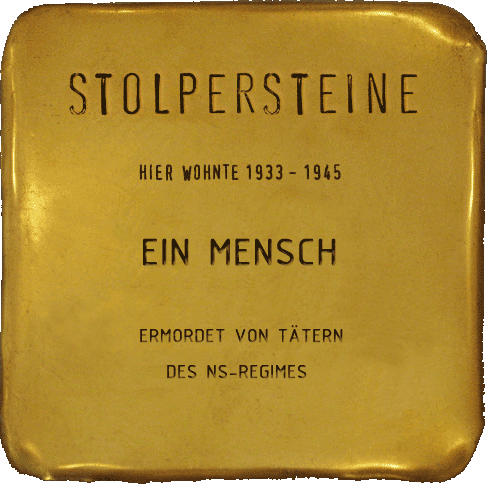 | ||
Similar Auschwitz concentration camp, Sachsenhausen concentration camp, Memorial to the Murdered, Yad Vashem, Buchenwald concentration camp | ||
Stolperstein ceremony berlin 15oct2013
A stolperstein ( [ˈʃtɔlpəʁˌʃtaɪn] from German, literally "stumbling stone", metaphorically a "stumbling block" or a stone to "stumble upon", plural stolpersteine) is a cobblestone-size (10 by 10 centimetres (3.9 in × 3.9 in)) concrete cube bearing a brass plate inscribed with the name and life dates of victims of Nazi extermination or persecution. The stolperstein art project was initiated by the German artist Gunter Demnig in 1992, and is still ongoing. It aims at commemorating individual persons at exactly the last place of residency—or, sometimes, work—which was freely chosen by the person before he or she fell victim to Nazi terror, euthanasia, eugenics, was deported to a concentration or extermination camp, or escaped persecution by emigration or suicide. As of 31 January 2017, over 56,000 stolpersteine have been laid in 22 European countries, making the stolperstein project the world's largest decentralized memorial.
Contents
- Stolperstein ceremony berlin 15oct2013
- Stolperstein movie wmv
- Origin of the name
- Here lived
- First stolperstein
- A growing memorial
- Locations
- Netherlands
- Czech Republic
- Italy
- Other countries
- Stolperschwellen From here
- Opposition
- Support
- Reactions of passers by
- Development of a commemorative tradition
- Documentary film
- Stolpsterseine in different countries
- References
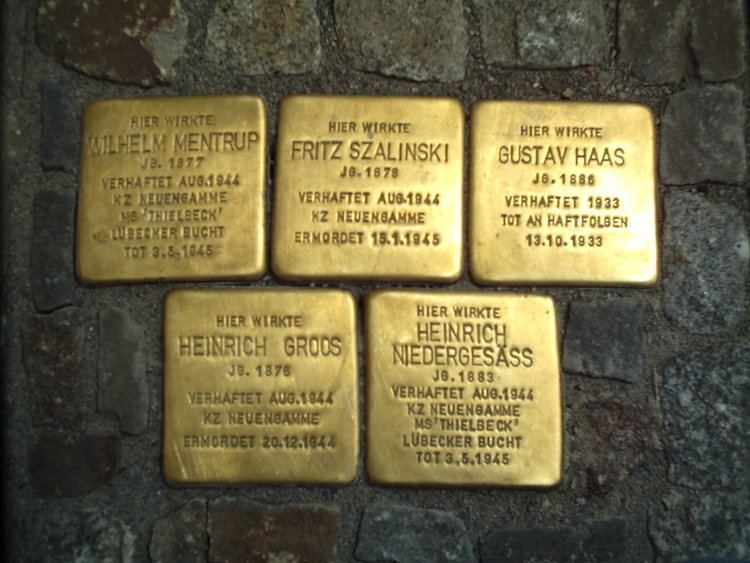
The majority of stolpersteine commemorate Jewish victims of the Holocaust. Others have been placed for Sinti and Romani people (then also called "gypsies"), homosexuals, Jehovah's Witnesses, black people, members of the Christian opposition (both Protestants and Catholics), the Communist Party and the European anti-Nazi Resistance, military deserters, and the physically or mentally disabled.

Stolperstein movie wmv
Origin of the name
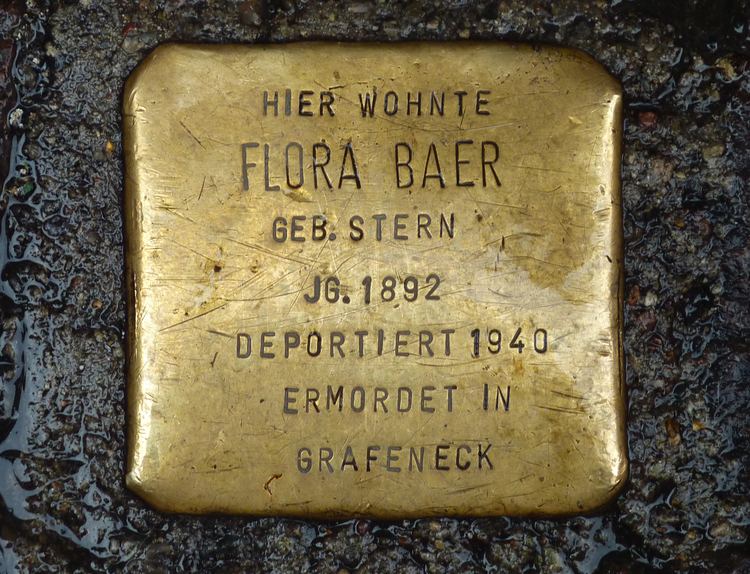
The name of the stolperstein project invokes multiple allusions: In Nazi Germany, an antisemitic saying, when accidentally stumbling over a protruding stone, was: "A Jew must be buried here". In a metaphorical sense, the German term Stolperstein can mean "potential problem". The term "to stumble across something", in German and English, can also mean "to find out (by chance)". Thus, the term provocatively invokes an antisemitic remark of the past, but at the same time intends to provoke thoughts about a serious issue. Stolpersteine are not placed prominently, but are rather discovered by chance, only recognizable when passing by at close distance. In contrast to central memorial places, which according to Demnig can be easily avoided or bypassed, stolpersteine represent a much deeper intrusion of memory into everyday life.
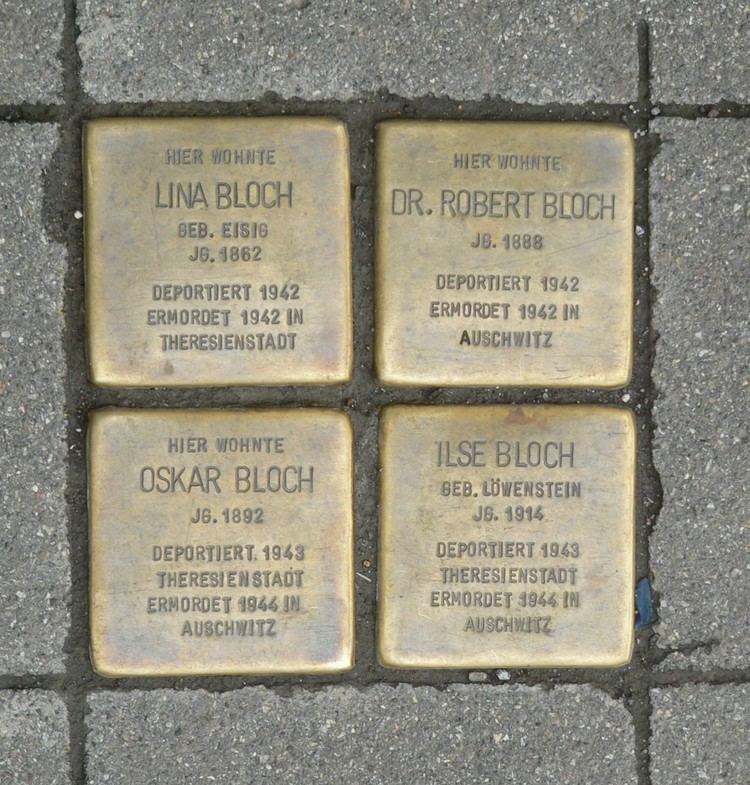
Stolpersteine are placed right into the pavement. When Jewish cemeteries were destroyed throughout Nazi Germany, the gravestones were often repurposed as sidewalk pavingstones. The desecration of the memory of the dead was implicitly intended, as people had to walk on the gravestones and tread on the inscriptions. The stolpersteine provocatively hint at this act of desecration, as they lack any kind of defense against new acts of shame. While the art project thus intends to keep alive the memory, implying that improper acts could easily happen again, the intentional lack of defense against potential desecration also created criticism and concern. Some German cities like Munich still do not accept the setting of stolpersteine, and look for alternative ways of commemoration instead.
"Here lived..."
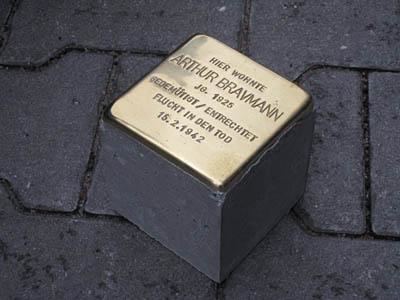
Research about future stolperstein locations is usually done by local school children and their teachers, victims' relatives, or local history organizations. The database of Yad Vashem in Jerusalem and the online database version of the 1939 Germany Minority Census are used to search for names and residential addresses of Nazi victims.
When research on a particular person is completed, Demnig sets out to manufacture an individual stolperstein. The person's name and dates of birth, deportation and death, if known, are engraved into the brass plate. The words Hier wohnte... ("Here lived...") are written on most of the plates, emphasizing that the victims of prosecution did not live and work at any anonymous place, but "right here". The stolperstein is then inserted at flush level into the pavement or sidewalk, at the individual's last known place of freely-chosen residence or work, with the intention to "trip up the passer-by" and draw attention to the memorial.
The costs of stolpersteine are covered by individual donations, local public fund raising, contemporary witnesses, school classes, or community funds. From the beginning of the project until 2012, one stolperstein cost €95. In 2012, the price increased to €120. Each individual stolperstein is still manufactured by hand, so that only about 440 of them can be produced per month. Today, it may take up to several months from the application for a new stolperstein until it is finally installed.
First stolperstein
On 16 December 1992, 50 years had passed since Heinrich Himmler had signed the so-called Auschwitz-Erlass ("Auschwitz decree"), ordering the deportation of Sinti and Roma to extermination camps. This order marks the beginning of the mass deportation of Jews from Germany. To commemorate this date, Gunter Demnig traced the "road to deportation" by pulling a self-built, rolling pavement-printing machine through the inner city to the train station, where the deportees had boarded the trains to the extermination camps. Afterwards, he installed the first stolperstein in front of Cologne's Historic City Hall. On its brass plate were engraved the first lines of the Auschwitz decree. Demnig also intended to contribute to the debate, ongoing at that time, about granting the right of residence in Germany to Roma people who had fled from former Yugoslavia.
Gradually, the idea arose of expanding the commemoration project to include all victims of Nazi persecution, as well as always doing so at the last places of residence which they were free to choose. A stolperstein would symbolically bring back the victims to their neighbourhoods, to the places where they rightfully belonged, even many years after they had been deported. In 1993, Gunter Demnig published further details of his project, and outlined his artistic concept in a contribution to the project Größenwahn – Kunstprojekte für Europa ("Megalomania: Art Projects for Europe"). In 1994, he exhibited 250 stolpersteine for murdered Sinti and Roma at St Anthony's Church in Cologne, encouraged by Kurt Pick, the parish priest. This church, located prominently in Cologne city center, was already serving as an important commemorative institution, and is part of the Cross of Nails community since 2016. In January 1995, these stolpersteine were brought to different locations in the city of Cologne, and laid into the pavements.
Another 55 stolpersteine were set up in the Kreuzberg neighborhood of Berlin in 1996, during the "Artists Research Auschwitz" project. In 1997, the first two stolpersteine were laid in St. Georgen, Austria, commemorating Jehovah's Witnesses Matthias and Johann Nobis. This had been suggested by Andreas Maislinger, founder of Arts Initiative KNIE and the Austrian Holocaust Memorial Service. Friedrich Amerhauser was the first mayor who granted permission to install stolpersteine within his city. Four years later, Demnig got permission to install 600 more stolpersteine in Cologne.
A growing memorial
As of October 2007, Gunter Demnig had already laid more than 13,000 stolpersteine in more than 280 cities. He expanded his project beyond the borders of Germany to Austria, Italy, the Netherlands and Hungary. Some stolpersteine were scheduled to be laid in Poland on 1 September 2006, but permission was withdrawn, and the project was cancelled.
On 24 July 2009 the 20,000th stolperstein was unveiled in the Rotherbaum district of Hamburg, Germany. Gunter Demnig, representatives of the Hamburg government and its Jewish community, and descendants of the victims attended. As of 15 May 2010, more than 22,000 stolpersteine had been set in 530 European cities and towns, in eight countries which had formerly been under Nazi control or occupied by Nazi Germany. By 8 July 2010, the number of stolpersteine had risen to more than 25,000, in 569 cities and smaller towns. As of 24 June 2011, Demnig had installed 30,000 stolpersteine.
In 2013, Gunter Demnig stated on his website:
During a talk at TEDxKOELN on 14 May 2013, Gunter Demnig announced the installation of the 40,000th stolperstein, which had taken place in Oldambt (Drieborg), Netherlands, on 3 July 2013. It was one of the first 10 stolpersteine in memory of Dutch communists who were executed by the German occupation forces after their betrayal by countrymen for hiding Jews and Roma. On 11 January 2015, the 50,000th stolperstein was installed in Torino, Italy for Eleonora Levi.
Locations
Stolpersteine are always installed in front of the last home which the victim had chosen freely. The most important source for potential locations is the so-called "Judenkartei" (Jews register), which was set up at the 1939 census of Germany as of 17 May 1939. In cases where the actual houses were destroyed during World War II or during later restructuring of the cities, some stolpersteine were installed at the former site of the house.
By the end of 2016, Gunter Demnig and his co-workers had installed about 60,000 stones in more than 1200 towns and cities throughout Europe:
Netherlands
From 2007 on, Demnig was – and still is – frequently invited to place stolpersteine in the Netherlands. The first city to do so was Borne. As of 2016, 82 stolpersteine have been installed there. By January 2016, in total, more than 2,750 stolpersteine have been laid in 110 Dutch cities and townships, including Amsterdam, Den Haag and Rotterdam, but particularly in smaller cities like Hilversum (92 stolpersteine), Gouda (183), Eindhoven (244), Oss and Oudewater (263 each).
Czech Republic
In the Czech Republic, the work on stolpersteine started on 8 October 2008 in Prague. Today, stolpersteine are found in nearly the entire area of the country. As of January 2016, the exact number of stolpersteine has not yet been established, but the main work was done in the larger cities, including Prague, Brno, Olomouc and Ostrava. In the small cities of Tišnov there are 15, and in Lomnice u Tišnova 9 stolpersteine. One of them commemorates Hana Brady, who was murdered at the age of 13. Since 2010, a stolperstein in Třeboň also commemorates her father.
Italy
Work in Italy began in Rome on 28 January 2010; there are now 207 stolpersteine there. In 2012, work continued in the regions of Liguria, Trentino-Alto Adige/Südtirol and Lombardia. Veneto and Tuscany joined in 2014, Emilia-Romagna in 2015, Apulia, Abruzzo and Friuli-Venezia Giulia in 2016, Marche in 2017. In Italy, marked differences are observed, as compared to other countries: Many stolpersteine are dedicated not only to Jewish people and members of the political resistance, but also to soldiers of the Italian army who were disarmed, deported to Germany, and had to work as forced laborers there. They were given special status so that they were not protected as prisoners of war under the Geneva Conventions after Italy left the coalition of the Axis powers after 8 September 1943.
Other countries
So far, no stolpersteine have been installed in Denmark, as only 2% of the Danish Jewish population were deported, thanks to the successful opposition of the Danish government, who refused to introduce the Yellow badge and to apply the Nuremberg Laws within their occupied country. In particular, more than 7,200 Danish Jews were saved by the Danish population shortly before their intended deportation by the Nazi occupants.
Surprisingly, stolpersteine have also been installed in Switzerland and Spain, even though these countries were never occupied. Stolpersteine in Switzerland mostly remember people who were caught smuggling illegal written material at the German border. In Spain, a large number of Republicans who fled from Spain to France after Francisco Franco's victory were caught by the Nazis after they had invaded France, and were either handed over to the Vichy regime, or deported to Mauthausen-Gusen concentration camp. About 7,000 Spanish people were held prisoner there, and were subjected to forced labour; more than half of them were murdered. The survivors were denationalized by the Franco regime, and became stateless persons, who were denied any form of recognition as victims, and deprived of any reparation.
Even in countries where no stolpersteine are installed, such as the United States, the decentralized monument of the stolpersteine has attracted media attention.
Stolperschwellen: "From here..."
In special cases, Demnig also installs his so-called "Stolperschwellen" ("stumbling thresholds"), measuring 100 by 10 centimetres (39 by 4 in), which serve to commemorate entire groups of victims, where there are too many individuals to remember at one single place. The text usually starts with the words: "Von hier aus..." ("From here..."). Stolperschwellen are installed at Stralsund main station. From there, 1,160 mentally ill persons were deported in December 1939, victims of the forced euthanasia program Action T4, and murdered in Wielka Piaśnica.
Other stolperschwellen commemorate female forced labourers from Geißlingen, who were imprisoned in the Natzweiler-Struthof concentration camp, the victims of the Holocaust in Luxemburg in Ettelbrück, forced laborers in Glinde, victims of forced euthanasia in Merseburg, and the first deportees, Roma and Sinti from Cologne. Further stolperschwellen exist in Bad Buchau, Berlin-Friedenau, Nassau, another in Stralsund, and one in Weingarten. A stolperschwelle was set up in Thessaloniki in front of the house in which Alois Brunner and Adolf Eichmann had planned the deportation and annihilation of 96.5% of the Jewish population of the town.
Opposition
The city of Villingen-Schwenningen heatedly debated the idea of allowing stolpersteine in 2004, but voted against them. There is a memorial at the railway station and there are plans for a second memorial.
Unlike many other German towns, the city council of Munich in 2004 rejected the installation of stolpersteine on public property, following objections raised by Munich's Jewish community (and particularly its chairwoman, Charlotte Knobloch, then also President of the Central Council of Jews in Germany, and herself a former victim of Nazi persecution). She objected to the idea that the names of murdered Jews should be inserted in the pavement, so that people might accidentally step on them with their feet. The vice president of the Central Council, Salomon Korn, however, warmly welcomed the idea at the same time. Christian Ude, then mayor of Munich, warned against an "inflation of monuments". Demnig also took part in the discussion, stating that "he intends to create a memorial at the very place where the deportation started: at the homes where people had lived last". The ban was reconsidered and upheld in 2015; other ways of commemoration, like plaques on the walls of individual houses, and a central memorial displaying the names of the people deported from Munich, will be set up.
In other cities, permission for the project was preceded by long, sometimes emotional discussions. In Krefeld, the vice-chairman of the Jewish community, Michael Gilad, said that Demnig's memorials reminded him of how the Nazis had used Jewish grave stones as slabs for sidewalks. A compromise was reached that a stolperstein could be installed if a prospective site was approved by both the house's owner and (if applicable) the victim's relatives. The city of Pulheim denied permission to pose a Stolperstein for 12 year old Ilse Moses, who was deported from Pulheim and murdered by the Nazi regime. The majority in the city counsel, CDU and FDP, opposed the project and prevented it. Starting in 2009, 23 Stolpersteine for the Belgian city Antwerp have been produced but could not be collocated due to local resistance against the project. They have been stored in Brussels where they are regularly exhibited.
Support
The majority of German towns welcome the installation of Stolpersteine. In Frankfurt am Main, which had a long tradition of Jewish life before the Holocaust, the 1000th stolperstein was set in May 2015, and newspapers publish progress reports and invitations for citizens to sponsor further memorial stones. In Frankfurt, the victim's descendants are not allowed to sponsor stolpersteine; these have to be paid for by the current inhabitants of the house, ensuring that they will respect the monument.
Reactions of passers-by
People's attention is drawn towards the stolpersteine by reports in newspapers and their personal experience. Their thoughts are directed towards the victims. Cambridge historian Joseph Pearson argues that "It is not what is written [on the stolpersteine] which intrigues, because the inscription is insufficient to conjure a person. It is the emptiness, void, lack of information, the maw of the forgotten, which gives the monuments their power and lifts them from the banality of a statistic."
Development of a commemorative tradition
Often the installation of a new stolperstein is announced in local newspapers or on the cities' official websites and is accompanied by a remembrance gathering. Citizens, school children and relatives of the persons who are commemorated on the plates are invited to take part. Often the citizens state that they are motivated by the idea that "they were our neighbors", and that they wish to remember the victim's names, or, symbolically, allow the deported to return to the place where they rightfully belong. If the person remembered on the plate was Jewish, their descendants are invited to attend the installation of the stone, and pray Kaddish, if they wish to do so.
Stolpersteine are installed in places where they are exposed to all kinds of climatic conditions, dust and dirt. As the brass material of the plates is subject to superficial corrosion, it will become dull over time if it is not cleaned from time to time. Demnig recommends regular cleaning of the plates. Many regional initiatives have set up schedules for cleaning and acts of remembrance, when stolpersteine are adorned with flowers or candles. Often remembrance days are chosen for these activities:
In May 2016, the Frankfurter Allgemeine Zeitung published an invitation to all citizens to clean the stolpersteine in front of their homes on 5 May 2016, the same day when Israel officially celebrated Yom HaShoah.
Documentary film
A documentary, Stolperstein, was made by Dörte Franke in 2008.
